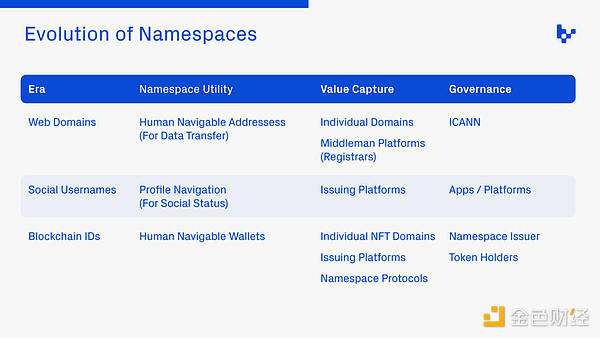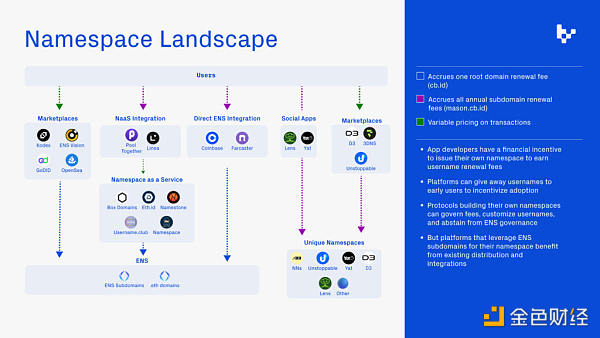Author: Mason Nystrom, Variant Fund investment partner; Translation: 0xjs@金财经
Some new companies have emerged that provide naming services to projects and individuals, and I think there are enough companies now Call it an exciting new trend. Namespaces provide a viable business model for a subset of consumer applications with large distribution channels.
Whether it’s a domain extension, a social media username, or a phone number (such as 1-800-FLOWERS), unique numeric identifiers have been popular since the first web domain names and will IP addresses are converted into human-readable names and gain value through their searchability as the Internet continues to grow in popularity.
Surprisingly, the rise of social networking has made the namespace market less liquid because you can't easily buy someone's account on a web2 social platform. Twitter has even banned the sale of user IDs, which is ironic for a company that desperately needs more sustainable cash flow.
 Although the .eth namespace has existed for many years, cross The integration of the Chain Interoperability Protocol ( CCIP ) further stimulates the creation of new namespaces by connecting ENS subdomains with traditional off-chain domains. For example, in August, Coinbase leveraged ENS and CCIP to begin providing its users with blockchain usernames under the DNS domain name cb.id, such as my masongnystrom .cb.id is both a DNS address and a web3 wallet address.
Although the .eth namespace has existed for many years, cross The integration of the Chain Interoperability Protocol ( CCIP ) further stimulates the creation of new namespaces by connecting ENS subdomains with traditional off-chain domains. For example, in August, Coinbase leveraged ENS and CCIP to begin providing its users with blockchain usernames under the DNS domain name cb.id, such as my masongnystrom .cb.id is both a DNS address and a web3 wallet address.
With the rise of namespace issuers, crypto consumer applications will have the opportunity to create their own native namespaces, but this time, we will be able to have social usernames or root names space (such as ENS) for governance. With this capability comes lucrative opportunities for top crypto consumer applications and their early adopters.
So far, blockchain projects that want to create an on-chain namespace have the following two path options: 1. Use ENS subdomain name activates its namespace; 2. Activate the native namespace protocol of its own application to provide services for its platform.
See the following figure for an overview of existing namespace projects:

How to decide whether to build your own namespace
Social graphs such as ENS can be leveraged to bootstrap an identity layer for new applications. Coinbase, a platform where public user identity is not fundamental to the product experience, has chosen to use ENS subdomains to quickly generate user identities while also enjoying the benefits of DNS compatibility and integration with important distribution layers like MetaMask. Farcaster similarly decided to leverage ENS because it has a pool of high-value users who want their existing identities (such as their .eth addresses) to be visible in Farcaster's social graph.
On the other hand, projects such as Lens and Yat have chosen to separate from the ENS ecosystem by creating their own namespace protocols for issuing usernames. These unique namespaces have a similar value proposition to ENS subdomains, but with greater protocol flexibility, autonomy from third-party issuers, and the unique advantage of earning fees from namespace issuance and annual renewal fees.
The purpose of charging for updates to namespaces in social networks is not just to generate revenue, it also prevents speculators from preempting it Valuable namespace, which is a good thing as the social network matures and attracts more users. Additionally, crypto-social applications or protocols like Lens will use usernames in their unique namespace as an incentive to join the network, providing first movers with their preferred namespace, as well as monetizing the namespace in a timely manner once a certain network density is reached potential.
However, platforms building their own namespace protocols give up the benefits that come with building on top of ENS, most notably a large ecosystem of integrations that already have .eth addresses and are tied to ENS Existing user base for speculation on subdomains.
The on-chain namespace provides a viable business model and incentive mechanism for new encrypted social networks. Most applications are best served by leveraging ENS subdomains as namespaces and publishing these usernames to users for free. In the long term, platforms with socially relevant namespaces or with sufficient discovery and distribution (e.g. social networks) will have the best chance of bootstrapping their own namespace protocols and charging username renewal fees.
 JinseFinance
JinseFinance
 JinseFinance
JinseFinance CoinMarketCap
CoinMarketCap decrypt
decrypt Coinlive
Coinlive  cryptopotato
cryptopotato Bankless
Bankless Coin Metrics
Coin Metrics 链向资讯
链向资讯 Nulltx
Nulltx Cointelegraph
Cointelegraph